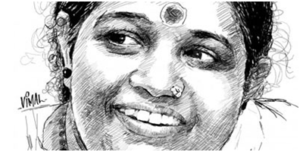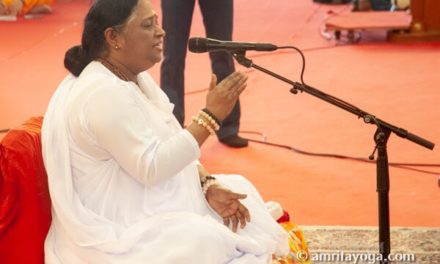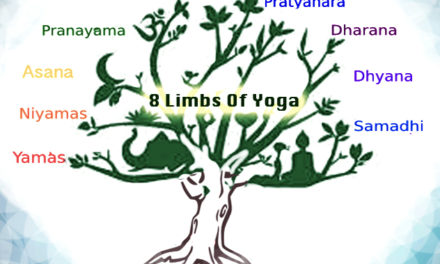 Let us also consider the aspects of mental and emotional health. The yogic systems include these aspects as part of the sheaths and chakras, the subtle bodies to be purified with sadhana. Practices including asana, pranayama and meditations to focus the mind on the Supreme within were all created to cleanse the subtle bodies. Each asana not only works on the physical level, but also works on the subtle levels. For example, chest opening asanas such as Supta Baddhakonasana allow for expulsion of impurities blocking the flow of prana to the heart.
Let us also consider the aspects of mental and emotional health. The yogic systems include these aspects as part of the sheaths and chakras, the subtle bodies to be purified with sadhana. Practices including asana, pranayama and meditations to focus the mind on the Supreme within were all created to cleanse the subtle bodies. Each asana not only works on the physical level, but also works on the subtle levels. For example, chest opening asanas such as Supta Baddhakonasana allow for expulsion of impurities blocking the flow of prana to the heart.
Teachers should be aware that asking students to attempt such asanas can be quite intense. The yoga studio may not be the place where a woman who has experienced sexual abuse is able to freely let go of her emotions. Great negativity can be cleansed through asana and room needs to be found for that to occur. After all, it is the whole point of purification. This leads to an interesting aspect of health. What should students be told who continue to practice Hatha yoga and keep having more and more negativity appear in their lives? This often occurs in meditation as well. On the surface this certainly does not look like good health. These people are trying to do something good for themselves and, as a result, are experiencing more suffering. How can this be justified as good health? Good teachers know this is part of the purification process. Discrimination is called for here. It all depends upon the individual. Where are they in their journey? What is their path? What is their goal? It may not be the same as ours, it may not even be yoga; instead, it may be to relieve the pain in their shoulder.
In the west, we may recommend a counselor for someone who is experiencing intense mental/emotional purgation. The counselor aims to help them to find methods to overcome their difficult experiences and to obtain good mental/emotional health. This is a good system. However, eventually one must go beyond the mind and emotion to beingness.
The mind is part of maya (delusion). It is to be renounced in order to obtain ‘Union’. In India, western counseling methods appear to be leading one astray. The mind needs to be focused and concentrated on God in order to reach the Goal. Practices of chanting, kirtan, seva, dhyana and dharana lead away from distractions by focusing the mind on God. It takes a lot of practice to remain centered in compassion and love when one is expunging intense negativities through purificatory practices.
In Bhakti yoga, chanting a mantra, especially a mantra received by a guru, is one solution. By focusing the mind on forms of the Divine such as “OM Namah Shivaya” all impurities are offered to the Ishta-devata (beloved deity) in order that they may purify us. In India, devotees also go to the temple priests or to astrologers to find out what pujas or homas to perform in order to overcome malefic influences.
A yoga instructor in India may give pranayama instructions to help clear the negativities. However, teachers in the west cannot responsibly tell students who are practicing Hatha yoga to breathe through intense negativities and just try to replace their thoughts with constant mantra like the single-mindedness of a true devotee. This takes practice. To some it comes naturally, to others it may take a lifetime. These methods are quite unfamiliar to the average person practicing Hatha yoga in the west.
Yogic methods of chanting and pranayama can be encouraged, however the student should also be encouraged to do what they feel comfortable within the context of their own culture. The teacher must be a true karma yogi, being aware of the needs of their students and offering the best support and compassion possible in each situation.
In conclusion, the definition of health is as variable as the people walking the path. We all want good health. Does yoga bring us good health? It may or it may not. This can be a misnomer of yoga; that one who practices will be of radiant health. Good health may mean what is good for us on the path to the Goal. If the karma of the sadhaka is such that illness is the necessary purification for the soul, the sadhak who is truly devoted to the path will accept illness. In this instance, we must surrender our own concept of what we consider good health and accept that we may never acquire our desired level of “health”. It is our devotion and faith that keep us destined for enlightenment.
Take, for example Ram Dass, the famous devotee of Neem Karoli Baba. Here is a man who is entirely devoted to the path of yoga and yet has experienced a severe stroke rendering him disabled. He claims this experience has brought him closer to God. Swami Paramatmananda, a disciple of Sri Mata Amritanandamayi Devi, has suffered severe pain in his lifetime. He asked his Sadguru to take away the pain. She gave him an option, take the pain away and be reborn or experience the pain as part of purification and reach Moksha (enlightenment). He chose to experience the bad health.
Teachers must keep in mind that each student will progress according to their own samskaras (latent impressions) and that to view physical health as a point of progress can be misleading. One who has illness may be closer to the Goal because of an open heart. Does this mean having cancer equals good health? This is an interesting paradox. Just because another can put their foot behind their head, this is not an indication of progress or results on the true path. We must ask “Does this bring us closer to God?” The practice may or may not. If it brings us closer to God it is considered yoga and could be categorized as good health. If it does not then we must ask, “Is it building our ego and keeping us in bondage?” We must think about changing our focus if the answer is yes.
It is necessary to put forth effort to obtain good health to be able to be of service to humanity and to help us to reach the Goal. But, we must not be attached to the results even if we find that, after years of sadhana, we still do not have glowing health. If we are truly devoted, we must give the fruits of our labors over to the Divine and continue to walk the path, accepting whatever results come back to us.
Author: Vandana Easterbrooks




